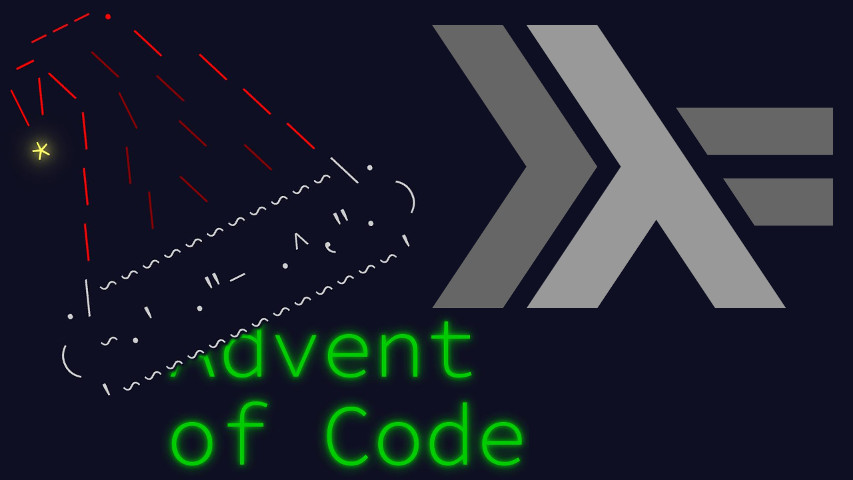For day 22 of Advent of Code, the “Reactor Reboot” problem asks us to count the number of active voxels after a simplified series of CSG operations. This post is literate Haskell and these are its imports.
import Control.Arrow ((&&&))
import Data.Array.Unboxed hiding ((!))
import Data.Foldable (foldMap')
import Data.List (group,sort)
import Data.Monoid (Sum(Sum))
import Data.Vector ((!))
import Text.Regex.Posix ((=~),getAllTextSubmatches)
import qualified Data.Vector as VThe problem space is cartesian-indexed 3D voxels.
type Pos = (Int,Int,Int)The operations are provided as a series of activations or deactivations on a specific rectangular cuboid.
type Step = (Bool,(Pos,Pos))The initialization sequence runs on a space of volume 1003, that easily fits in RAM,
packed or not. So let’s just run it directly there, on an
Array of Bools.
apply :: [Step] -> Array Pos Bool
apply = accumArray (flip const) False ((-50,-50,-50),(50,50,50)) .
concatMap (\(st,r) -> zip (range r) (repeat st))The hardest part of the problem may be filtering the actual steps that matter for the initialization phase. I do appreciate Eric not playing with edge cases of any kind there: all steps provided in the input are either entirely within the init section or entirely outside.
filterInit :: Step -> Bool
filterInit (_,((x1,y1,z1),(x2,y2,z2))) =
minimum [x1,y1,z1] >= -50
&& maximum [x2,y2,z2] <= 50Putting it all together, part 1’s a breeze.
part1 :: [Step] -> Int
part1 = length . filter id . elems . apply . filter filterInitFor part 2, things get trickier: there are no given bounds on the observed region, and in input they’re in the order of 200 0003 = 8 × 1015, which definitely doesn’t fit in (my) RAM.
But the input itself is not as large. Mine is only 420 lines long. This means there are at most 840 possible divisions along each axis. So if we were to count pseudovoxels only along those planes, we’d have about 8403 ≈ 6 × 108 of them to manage. Which is large, but not intractable.
Let’s redefine the data structures along this new coordinate space.
newtype Int' = I' Int deriving (Eq,Ord,Ix,Show)
type Pos' = (Int',Int',Int')
type Step' = (Bool,(Pos',Pos'))Now to convert to and from, we’ll need the actual division points.
type Split = (V.Vector Int,V.Vector Int,V.Vector Int)
splitPoints :: [Step] -> Split
splitPoints ss = (V.fromList (nub' xs),V.fromList (nub' ys),V.fromList (nub' zs))
where
ps = concatMap (\(_,(p1,(x2,y2,z2))) -> [p1,(x2+1,y2+1,z2+1)]) ss
(xs,ys,zs) = unzip3 ps
nub' = map head . group . sortThe tricky aspect is the off-by-ones: cuboids are provided with inclusive bounds, so:
- a cuboid’s lower bound means “split before”
- a cuboid’s upper bound means “split after”
So the split table maps indices to “split befores”, and the rest of the code adjusts around the “split afters”:
- generating the split table converts an upper bound to a split before a virtual lower bound of +1 on every axis
- converting a step to compact space looks up the same +1
convertSplit :: Split -> Step -> Step'
convertSplit (xs,ys,zs) (st,((x1,y1,z1),(x2,y2,z2)))
= (st,((x1',y1',z1'),(x2',y2',z2')))
where Just x1' = I' <$> V.elemIndex x1 xs
Just y1' = I' <$> V.elemIndex y1 ys
Just z1' = I' <$> V.elemIndex z1 zs
Just x2' = I' . subtract 1 <$> V.elemIndex (x2+1) xs
Just y2' = I' . subtract 1 <$> V.elemIndex (y2+1) ys
Just z2' = I' . subtract 1 <$> V.elemIndex (z2+1) zsWith the split vectors at hand, conversion was basically a lookup.
Applying the operations now works the same, just on the dual type.
apply' :: Split -> [Step'] -> UArray Pos' Bool
apply' (xs,ys,zs) =
accumArray (flip const) False
( (I' 0,I' 0,I' 0)
, (I' (length xs - 1),I' (length ys - 1),I' (length zs - 1)) ) .
concatMap (\(st,r) -> zip (range r) (repeat st))Counting the volumes to yield the result is obviously a bit more complex: we’re not counting voxels anymore, but summing their expanded volumes instead.
count :: Split -> UArray Pos' Bool -> Sum Int
count (xs,ys,zs) a = foldMap' volume (fst <$> filter snd (assocs a))
where
volume (I' x',I' y',I' z') = Sum (δx * δy * δz)
where δx = xs!(x'+1) - xs!x'
δy = ys!(y'+1) - ys!y'
δz = zs!(z'+1) - zs!z'The part 2 wrapper is similar to the previous one. Most notably the split vectors are passed along to most operations.1
part2 :: [Step] -> Sum Int
part2 steps = count s $ apply' s $ convertSplit s <$> steps
where s = splitPoints stepsThe rest of the code is presented for completeness, but not so interesting.
parse :: String -> [Step]
parse = map parseStep . lines where
parseStep l = (st,((x1,y1,z1),(x2,y2,z2))) where
(_:st_:rawCoords) = getAllTextSubmatches $
l =~ ( "(on|off) x=" ++ n ++ ".." ++ n ++
",y=" ++ n ++ ".." ++ n ++
",z=" ++ n ++ ".." ++ n )
st = st_ == "on"
[x1,x2,y1,y2,z1,z2] = read <$> rawCoords
n = "(-?[0-9]+)"
main :: IO ()
main = interact $ show . (part1 &&& part2) . parseThe code runs in about 50 seconds, which I think is by far the longest so far. But it was feasible with very simple code, skirting the CSG issue altogether, which I think has a lot of intrinsic value. Yet another engineering vs runtime tradeoff, I guess.
But I may revisit! 😀
This concludes today’s solution. See you tomorrow!
Please don’t suggest I “simplify” things with a Reader monad.↩︎



